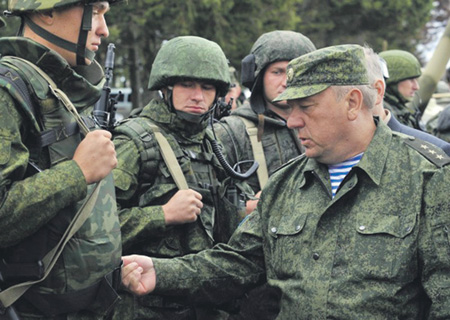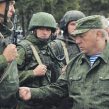
Moscow Announces the Creation of Rapid Reaction Forces—Again
Publication: Eurasia Daily Monitor Volume: 12 Issue: 107
By:

Russia’s top brass re-announced the creation of rapid reaction forces, with overall numbers of up to 70,000, based upon the existing elite Airborne Forces (Vozdushno Desantnye Voyska—VDV). The idea of creating such a capability is hardly new, but the timing of its latest incarnation is interesting in that it coincides with the summer combat training period and the ongoing crisis in Ukraine. Sources in the General Staff indicated that the VDV will be wholly integrated into the new rapid-reaction force, but the timing of its completion was less than clear. The commander of the VDV, Colonel-General Vladimir Shamanov, envisages the final force strength for the airborne troops of around 60,000; representing an increase of 15,000 (Argumenty i Fakty, June 4).
General Shamanov suggested that the priority of the summer training cycle is to maintain momentum in developing the Russian military. Shamanov also commented that he was once asked about receiving a foreign travel visa, to which he responded by saying “we [VDV] do not need a visa, we need only the order of the supreme commander.” Part of the reason for the upsurge in training is also about preparing forces for forthcoming strategic-operational exercises; Tsentr 2015 and Union Shield 2015 (Nezavisimoye Voyennoye Obozreniye, June 5).
Shamanov’s key message, however, is that the plans to develop rapid reaction force capabilities with the VDV serving as its backbone alongside Special Operation Forces, marine infantry and GRU Spetsnaz (military intelligence special forces) have resurfaced and appear to be nearing actual implementation. This prompted some Russian media commentaries to link the move to a political-military reaction to the North Atlantic Treaty Organization’s (NATO) plans to form a “spearhead” element of its own rapid reaction forces in order to reinforce Baltic and Eastern European security. However, the actual sources of Moscow’s initiative seem rooted in the internal development of Russia’s Armed Forces, building on existing experience with other “rapid reaction” capabilities within the Collective Security Treaty Organization (CSTO) and Russian threat assessments (Nezavisimoye Voyennoye Obozreniye, June 1).
Within the CSTO, for example, Russia already contributes forces from the VDV—the 98th Airborne Division and the 31st Air Assault Brigade—to the Collective Rapid Reaction Forces (Kollektivnye Sil Operativnogo Reagirovaniya—KSOR). In May, the KSOR held a military exercise in Tajikistan, rehearsing deployment to reinforce the Tajikistani-Afghan border (Ozodi.org, May 18). Nevertheless, in the latest iteration of rapid reaction force planning, Shamanov believes that the VDV will gain tank battalions and, by 2020, be manned by 80 percent contract personnel (Nezavisimoye Voyennoye Obozreniye, June 1). Efforts to raise the number of contract personnel in the VDV are consistent with plans to increase the proportion of contract servicemen in the Armed Forces in order to be less reliant upon conscripts; this is complemented by some shifts in recruitment and the use of mobile and other static recruitment points and recruiting directly from the population (Krasnaya Zvezda, May 19).
Underlying these developments and the various remarks by Shamanov is a tension within the force development of the VDV that reflects the wider issue with the overall Armed Forces: that is, between modernizing and adopting “command, control, communications, computers, intelligence, surveillance and reconnaissance” (C4ISR) or network-centric approaches to warfare, and relying on old-style combined arms and over-reliance upon tank-centric approaches. This is accomplished by increasing the number of personnel. The move is driven by adding tank support units into its order of battle and the introduction of the automated command-and-control system “Andromeda” to facilitate C4ISR and support a greater drive toward conventional network-centric capabilities and reduce reliance upon nuclear systems in an escalating conflict. Undoubtedly, the conservatives within the top brass will point to the role played in Donbas by Russian tank platforms. Yet, with the Kremlin sticking to “deniability” of Russian actions in Ukraine, any sense of debate may be publicly stifled. This leaves the modernizers claiming higher ground and pointing to the success of Andromeda as the way forward in modernizing the VDV (Vzglyad, May 6).
In terms of a tank capability for the VDV, though not entirely new in itself (such as PT-76 or Sprut-SD light tank models), Shamanov says, “In the very near future we plan to acquire tank subunits in order to strengthen firepower.” It appears he advocates the addition of modern airdropped self-propelled artillery mounts, comparable to light tanks. Such tank units would include either a few vehicles or up to several dozen. This novelty is certainly attracting attention within the Russian military press. Colonel Valeriy Yuryev, Deputy Chairman of the Central Council of the Paratroopers’ Union of Russia, noted that, “Although during the time of the Soviet Union paratroopers executed tasks in the rear of the enemy in airdropped equipment, now the VDV is faced with tasks that are in part those of the Infantry Troops. Naturally, providing tanks will raise firepower and the anti-tank capabilities of VDV units and subunits” (Vzglyad, May 6).
In stark contrast, the VDV is also adopting a new highly technically advanced automated command-and-control system—Andromeda. This has now gone beyond field testing, and its introduction into the branch of service will assuredly increase demand for tech-savvy contract personnel. Captain Vladimir Sankin, a VDV officer, described some of its elements. Andromeda is a fully domestically produced system, specially crafted for the needs of the VDV. Taking account of the VDV’s combat mobility, the Andromeda “provides effective management of units in any situation using the most modern digital telecommunications equipment, which includes radio operating in different bands, radio relay stations, space communications, command and staff vehicles of the latest generation,” Sankin explained. In order to operate the system, the operator requires “deep theoretical knowledge and practical skills.” Contract personnel and officers are responsible for training service personnel to handle the system, and to develop an understanding of its functions and its value. In short, at the levels of command, control and communications (C3), it introduces decision making in real time and makes a step toward Russian network-centric warfare capabilities (Krasnaya Zvezda, May 20).
In the context of Moscow’s unacknowledged actions in Ukraine, the Russian General Staff may be drawing the conclusion that tank-centric approaches will remain important on Russia’s periphery for the foreseeable future. But the Andromeda and Shamanov’s renewed interest in enhanced rapid-reaction capabilities confirm continued tension between modernists and traditionalists within Russia’s military. Modeling the needs for future operations close to Russia will depend on how the General Staff assesses the performance of Russian forces in Ukraine.




